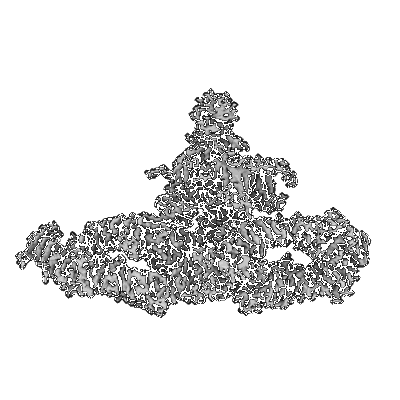EMD-25493
Human NALCN-FAM155A-UNC79-UNC80 channelosome with CaM bound, conformation 2/2
EMD-25493
Single-particle3.5 Å
 Deposition: 22/11/2021
Deposition: 22/11/2021Map released: 29/12/2021
Last modified: 16/10/2024
Sample Organism:
Homo sapiens
Sample: Pentameric complex of the leak channel NALCN with FAM155A, Calmodulin, UNC79 and UNC80
Fitted models: 7sx4 (Avg. Q-score: 0.359)
Deposition Authors: Kschonsak M, Chua HC
Sample: Pentameric complex of the leak channel NALCN with FAM155A, Calmodulin, UNC79 and UNC80
Fitted models: 7sx4 (Avg. Q-score: 0.359)
Deposition Authors: Kschonsak M, Chua HC

Structural architecture of the human NALCN channelosome.
Kschonsak M,
Chua HC  ,
Weidling C
,
Weidling C  ,
Chakouri N
,
Chakouri N  ,
Noland CL
,
Noland CL  ,
Schott K
,
Schott K  ,
Chang T,
Tam C,
Patel N,
Arthur CP,
Leitner A
,
Chang T,
Tam C,
Patel N,
Arthur CP,
Leitner A  ,
Ben-Johny M
,
Ben-Johny M  ,
Ciferri C
,
Ciferri C  ,
Pless SA
,
Pless SA  ,
Payandeh J
,
Payandeh J 
(2022) Nature , 603 , 180 - 186
 ,
Weidling C
,
Weidling C  ,
Chakouri N
,
Chakouri N  ,
Noland CL
,
Noland CL  ,
Schott K
,
Schott K  ,
Chang T,
Tam C,
Patel N,
Arthur CP,
Leitner A
,
Chang T,
Tam C,
Patel N,
Arthur CP,
Leitner A  ,
Ben-Johny M
,
Ben-Johny M  ,
Ciferri C
,
Ciferri C  ,
Pless SA
,
Pless SA  ,
Payandeh J
,
Payandeh J 
(2022) Nature , 603 , 180 - 186
Abstract:
Depolarizing sodium (Na+) leak currents carried by the NALCN channel regulate the resting membrane potential of many neurons to modulate respiration, circadian rhythm, locomotion and pain sensitivity1-8. NALCN requires FAM155A, UNC79 and UNC80 to function, but the role of these auxiliary subunits is not understood3,7,9-12. NALCN, UNC79 and UNC80 are essential in rodents2,9,13, and mutations in human NALCN and UNC80 cause severe developmental and neurological disease14,15. Here we determined the structure of the NALCN channelosome, an approximately 1-MDa complex, as fundamental aspects about the composition, assembly and gating of this channelosome remain obscure. UNC79 and UNC80 are massive HEAT-repeat proteins that form an intertwined anti-parallel superhelical assembly, which docks intracellularly onto the NALCN-FAM155A pore-forming subcomplex. Calmodulin copurifies bound to the carboxy-terminal domain of NALCN, identifying this region as a putative modulatory hub. Single-channel analyses uncovered a low open probability for the wild-type complex, highlighting the tightly closed S6 gate in the structure, and providing a basis to interpret the altered gating properties of disease-causing variants. Key constraints between the UNC79-UNC80 subcomplex and the NALCN DI-DII and DII-DIII linkers were identified, leading to a model of channelosome gating. Our results provide a structural blueprint to understand the physiology of the NALCN channelosome and a template for drug discovery to modulate the resting membrane potential.
Depolarizing sodium (Na+) leak currents carried by the NALCN channel regulate the resting membrane potential of many neurons to modulate respiration, circadian rhythm, locomotion and pain sensitivity1-8. NALCN requires FAM155A, UNC79 and UNC80 to function, but the role of these auxiliary subunits is not understood3,7,9-12. NALCN, UNC79 and UNC80 are essential in rodents2,9,13, and mutations in human NALCN and UNC80 cause severe developmental and neurological disease14,15. Here we determined the structure of the NALCN channelosome, an approximately 1-MDa complex, as fundamental aspects about the composition, assembly and gating of this channelosome remain obscure. UNC79 and UNC80 are massive HEAT-repeat proteins that form an intertwined anti-parallel superhelical assembly, which docks intracellularly onto the NALCN-FAM155A pore-forming subcomplex. Calmodulin copurifies bound to the carboxy-terminal domain of NALCN, identifying this region as a putative modulatory hub. Single-channel analyses uncovered a low open probability for the wild-type complex, highlighting the tightly closed S6 gate in the structure, and providing a basis to interpret the altered gating properties of disease-causing variants. Key constraints between the UNC79-UNC80 subcomplex and the NALCN DI-DII and DII-DIII linkers were identified, leading to a model of channelosome gating. Our results provide a structural blueprint to understand the physiology of the NALCN channelosome and a template for drug discovery to modulate the resting membrane potential.
